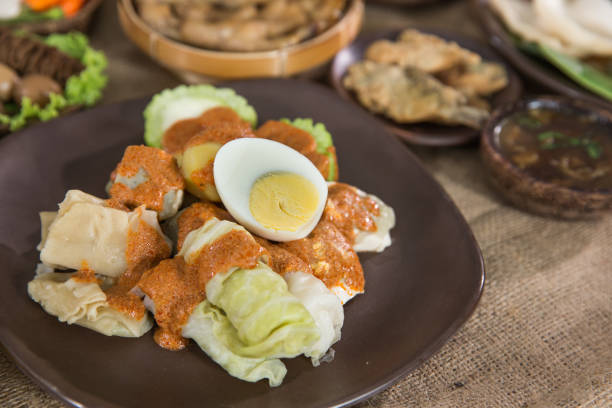Who would have thought that our favorite siomai may have been originated in Mongolia.
 |
| *Not an actual Mongolian |
Editor's Notes: This is a special series that tries to trace the historical origins of Cebu's most favorite and iconic food. Cebuano cuisine is a unique subculture in the greater Filipino gastronomy that requires a deeper dive into the historical, social, and cultural aspects of its roots. #CebuanoFoodOrigins
Introduction
Many Cebuano dishes and street food have Chinese roots due to its long historical ties with China and the subsequent Chinese diaspora in the late 1850s up to the early 1900s. Many of these immigrants have brought their unique food culture from their homeland and many have started their livelihood by selling their favorite dishes. While some of their dishes tried to stay true to what it was back in the old country, many of their dishes have soon evolved to fit the taste profile of the Filipinos.
 |
| Many Chinese earned a living by hawking food on the streets |
It is also important to note that many of these immigrants have found it difficult to get some of the key ingredients of authentic Chinese cuisine (including different regional varieties - Cantonese, Hokkien, Teochew, etc.) that they know in their newly-adopted country so their versions eventually embraced different local ingredients so that the fusion versions have become the dishes we all know and love. One of the many Chinese-Filipino dishes that have become favorites is 'Siomai sa Tisa.' It has become an institution in the Cebuano food scene.
Most Cebuanos don't know that it has gone a very long way to become what it is right now.
Origin Story
We tend to think that siomai is a Chinese-Filipino fusion food and it is justified since the former brought it here and the locals fell in love. Yet its true roots lay somewhere further away - in Mongolia. Yes, Inner Mongolia to be exact.
 |
| The Chinese embraced the siomai and eventually brought it to our shores |
What is now a go-to street food available all day long was once an obscure side dish served along with hot tea. Although dim sum cuisine originated during the Eastern Jin Dynasty (317-420), a lot of the component dishes (from dumplings to spring rolls) were developed centuries later. Although Mongols were nomadic people and consumed only meat and dairy products, they soon adopted the food of the more sedentary Han Chinese when they eventually conquered the Middle Kingdom.
In old historical accounts, it was known as 'shao mai' (捎賣; 捎卖) which meant 'sold as a sideline' as early as the Ming Dynasty (1368-1644). By this time, the decrepit rule of the Yuans (Mongol dynasty) in China had collapsed and the new rulers had shed themselves of their Mongol influence.
 |
| Shao mai became one of the centerpieces in dim sum cuisine |
Yet some of the Mongol culinary dishes managed to merge with mainstream Chinese cuisine and soon spread further south. From its roots in Hohhot in today's Inner Mongolia, it was brought to Beijing and Tianjin thanks to enterprising Shanxi merchants. By the late Qing Dynasty (1644-1911), China was already in turmoil due to widespread peasant revolts, political instabilities, and the arrival of foreign powers looking to carve up their lands into different spheres of influence. Many Chinese have ended up migrating elsewhere in search of better lives.
Siomai also went overseas with them and by the time it reached our shores, it had evolved to what it is today.
Why Tisa?
Although we have associated the Cebuano-style siomai with Tisa in Labangon. There is no clear historical basis to suggest if it really originated in this part of Cebu. We have to understand that most of the Chinese immigrants were relegated to their own ghetto in the Parian district during the Spanish times. Although many of them later enjoyed greater social mobility by the time the Americans were in charge, there is a relatively no records to suggest that Tisa is the provenance of this favorite street food.
It is interesting to point out that fast-food Chinese is not authentic Chinese cuisine, it's more like fusion cuisine.
 |
| You can have siomai for breakfast or a late-night snack |
One thing is for certain, Tisa is the culinary hotspot of this dish. The 'siomai sa Tisa' branding may have been born out of the desire to distinguish their own take on this classic Chinese (albeit Mongolian) dish over their competitors. So it would be more of a branding practice rather than a historical creation. The transition from its 'original' state to the modernized version took some time.
Finding out which came first between the chicken and the egg can be a long argument. As the siomai from that area has become a popular destination through the years, people have learned to identify it with that brand identity as their dumplings are distinct from other products thanks to its special chilli sauce made from minced garlic, chopped chilli pepper, and oil.
 |
| Some competitors even adopted the logo as their own |
It is said that Julmer Food Ventures, founded by Elmer and Julie Parba, has developed the 'D'Original Siomai sa Tisa' brand and many competitors tried to associate themselves with it by attaching "original" in their own branding. It was only in 2001 when the siomai's profile grew as snack house owner Jeffrey Quillosa introduced it to go well with their in-house halo-halo.
The overwhelming popularity of this dish has led local officials to dub their place the 'Siomai Capital of Cebu.' They also organized a Siomai festival around it to cash in on the potential culinary tourism value of the popular street food.
The 'Siomai' Multiverse
We're all familiar with the 'Siomai sa Tisa' yet there are a lot of variants of it across different countries and cultures. We can't say siomai is ours, there are interesting versions of it that you may have to know about.
Chinese Variants
It is interesting to point out that there is no such thing as a standard Chinese siomai, to begin with, as there are a lot of regional variations as well.
Cantonese siumaai

This is perhaps the most popular version and is considered the 'real' Chinese siomai that the world knows about. It consists primarily of ground pork, small whole or chopped shrimp, Chinese black mushroom, scallion, and ginger then seasoned with Chinese rice wine, soy sauce, sesame oil, and chicken stock.
Other versions include ingredients such as bamboo shoots, water chestnuts, and pepper. The wrapping is made of a thin sheet of lye water dough, which is either yellow or white. It is garnished with an orange (made from crab roe or diced carrot) or a green dot (made from pea).
Hohhot shaomai
In Inner Mongolia, their shaomai mainly consists of chopped or minced mutton, scallion, and ginger with wrappings made from a very thin, round sheet of unleavened dough. It has a dense consistency with a slightly spicy taste and is often served with vinegar and tea.
Uyghur shaomai

Somewhat similar to the Mongolian variants, the Uyghurs have two variants: the northern version consists of mutton or beef, along with green onion and radish; the southern version consists of glutinous rice with minimal mutton or beef.
Juhua shaomai

In Hunan province, their shaomai has a very distinctive opening that closely resembles the chrysanthemum flower petal shape. It has a peppery flavor on a translucent wrapper filled with glutinous rice, pork hash, shrimp, shiitake mushrooms bamboo shoots, and onion.
Jiangnan shaomai

From Shanghai to Nanjing, their shaomai is much larger than their Cantonese counterparts. Its filling contains marinated pork pieces in glutinous rice, soy sauce, and Shaoxing wine, steamed with pork fat. The ones in Shanghai have stir-fried shiitake mushrooms and onions.
Yifeng shaomai

In the southeastern Jiangxi province, their shaomai has a distinct flavor from a blend of minced pork, bread flour, sesame seed powder, ground pepper, and sugar.
Foreign Variants
Shaomai eventually spread to other countries, including the Philippines, and soon, new variants developed in Japan, Indonesia, and Vietnam.
Japanese shūmai

In Japan, shūmai is mainly made from pork and onion and then topped with green pea. Unlike the minced meat used in the Chinese variants, the Japanese ground the meat into paste.
Indonesian siomay

In Muslim-majority Indonesia (and even, Malaysia), siomay is usually made from various fishes like wahoo and mackerel. It is served also with steamed potatoes, tofu, hard-boiled eggs, steamed bitter gourd, and cabbages, all are sliced and topped with peanut sauce and kecap manis (sweet soy sauce).
Vietnamese xíu mại

Although heavily influenced by the Chinese, the Vietnamese xíu mại is made from minced pork, onion, scallion, and shredded bread cooked with tomato sauce. It resembles more like a meatball as it is usually served with a roll of bánh mì.
Key Ingredients
The divergence of siomai from shaomai can be attributed to the availability of ingredients and different taste profiles of the local population eating this culinary import. Various variants of the Chinese shaomai use a variety of ingredients such as Shaoxing wine, sesame sauce, water chestnuts, mutton, and other spices that are unavailable or rarely used in Filipino cuisine so the Chinese immigrants decided to improvise as the original ingredients fell out of favor. They further made adjustments to make it more palatable to the locals.
The Filipino variant incorporated seafood like shrimp or crab meat in addition to chilli oil and calamansi soy sauce. The chilli oil used in siomai is based on the Chiu Chow (also known as Chaozhou) chili oil from southern China. Filipinos have a more sour taste profile when it comes to savory foods so the addition of calamansi is part of the evolutionary process.
These days, we see new variations with the emergence of fried siomai that Chowking (the Chinese fast-food arm of Jollibee) has popularized. Changing the components like replacing wonton with nori seaweeds or adding hardboiled quail eggs. As we're used to the white or yellow wrappers, the 'Japanese' siomai is gaining popularity as it looks different from the usual siomai. Well, it's not the same as the real Japanese shūmai as they never used nori at all.
While the rest of the world uses chopsticks to pick up their siomai, Filipinos use toothpicks to pick up theirs.
Future Evolution
The future of siomai is expected to develop further as Filipinos continue to reinvent this age-old dish that moved away from the frigid wastelands of Mongolia to the cosmopolitan cities of Beijing, Shanghai, and Guangzhou, and eventually to the Queen City of the South.
References:
Inner Mongolian Snacks. Asia Cultural Travel.
"Shumai vs. gyoza | Both dumplings, but more different than similar," by Joost Nuselder. Bite My Bun.
"What's The Difference: Siomai Vs. Wonton Vs. Dumpling," by Roselle Miranda. Yummy.
"Village lays claim to ‘siomai’ fame," by Irene R. Sino Cruz. Philippine Daily Inquirer.
Chinese Food Cebuanos Love the Most. Cebu Insights.
"How Food Built And Killed The Mongol Empire," by Erik Brown. History of Yesterday.
History of the Philippines & its Food: A Timeline. The World in a Pocket.








COMMENTS